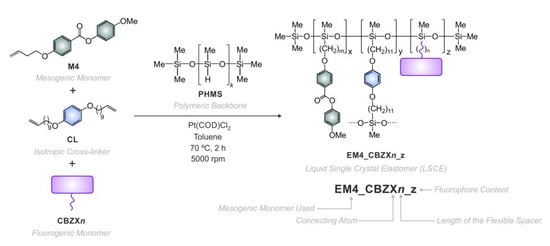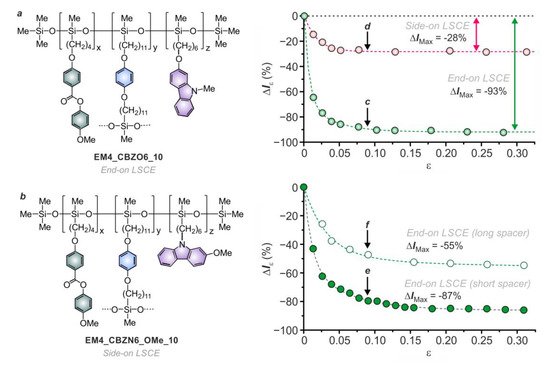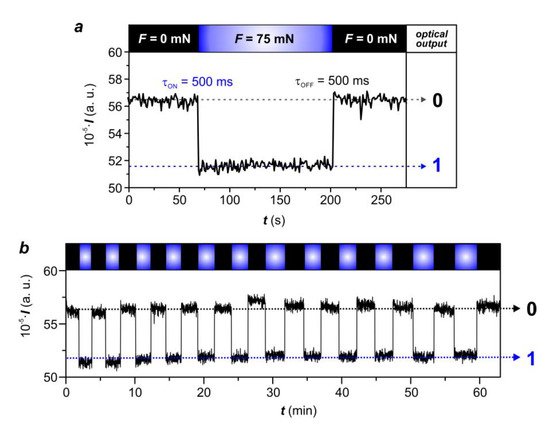Liquid single crystal elastomers (LSCEs) are weakly crosslinked polymer networks that combine the long range orientational order of liquid crystals, which is uniform along the whole sample, and the elasticity of conventional rubbers [
1]. Importantly, the supramolecular organization of the molecules that constitute the liquid-crystalline phase (also known as the mesophase), i.e., the mesogens, can be easily modified through the application of suitable stimuli. As a consequence, liquid-crystalline elastomers are adaptable materials that tune their macroscopic features as a response to specific external inputs [
2,
3]. For instance, when LSCEs that incorporate azo derivatives within their polymeric network are illuminated with light of the appropriate wavelength, the linear
trans form of the azo photochrome is transformed into its bent
cis counterpart. This photochemical transformation promotes a dramatic disorganization of the surrounding mesogenic molecules and translates into a significant shape change of the material at the macroscopic level. Because of this phenomenon, azobenzene-containing LSCEs find application as light-driven artificial actuators (i.e., materials capable of converting light into mechanical actions) [
4,
5,
6,
7,
8,
9,
10].
LSCEs can also be engineered to perform exactly the opposite task, that is, to encode mechanical inputs into optical signals. For this purpose, the intermolecular interactions established between the mesogenic molecules and rationally designed luminescent labels must be altered upon the application or release of a mechanical stimulus [
11,
12,
13,
14,
15,
16,
17,
18]. In this way, the introduction of selected organic fluorophores into this type of self-organized polymeric system enables the modulation of the amount of light emitted in the form of fluorescence upon deformation, giving rise to LSCE-based optical force sensors [
19]. To the best of our knowledge, only two examples of LSCE-based optical force sensors have been reported in addition to the ones described herein. In these instances, the distinct emission intensity, detected when the elastomeric material undergoes its nematic-to-isotropic phase transition, was exploited as the driving force of the sensor [
20,
21]. These materials require, however, relatively high temperatures to operate. During recent decades, non-liquid-crystalline polymers and elastomers have also been exploited as excellent matrixes to perform mechanochromic reactions for force sensing purposes. In these cases, mechanophoric components, typically spiropyranes and their derivatives, are covalently attached to a polymer backbone. In the relaxed state, the mechanophore is in its spiro closed form and the material is completely colorless. However, when the mechanical stimulus is applied, the opened merocyanine form of the mechanophore is generated and the material becomes colored, thus enabling the visualization of the applied force to the naked eye [
22,
23,
24]. Other mechanophores, such as diarylbibenzofuranones [
25] and bis(adamantyl)-1,2-dioxetane bisacrylate [
26], have also been explored for this purpose. Force sensing materials have also been achieved through the covalent attachment of mechanoresponsive organic fluorophores to non-liquid-crystalline polymers. In some of these examples, the sensing abilities of the material come from the fact that the organic fluorophore changes its aggregation state upon mechanical stimulation, thereby generating two distinct emissive states [
27,
28,
29]. Supramolecular chemistry has also been exploited recently to modulate the emissive properties of non-liquid-crystalline polymers and elastomers [
30,
31]. All these mechanosensitive networks find great application in actual technology as damage detectors. It is also interesting to stress at this point that mechanochemical reactions can also be performed in polymeric matrixes containing carefully chosen mechanophores with an extremely high spatial precision, permitting 3D nanoprinting and the production of nanodevices and nanosensors for measuring mechanical stress in situ [
32]. It should be also mentioned that non-polymeric materials, mainly crystalline solids, have also been proved to change their luminescence upon grinding, smearing, shearing, etc., due to drastic modifications of their crystalline structures [
33,
34,
35,
36,
37,
38,
39,
40,
41,
42,
43,
44,
45,
46,
47,
48,
49,
50,
51]. However, in many of these instances, the initial state of the system must be recovered either by recrystallization or by exposing the solid to vapors of a suitable solvent. This fact increases considerably the response time of the material and compromises its reversibility, thereby limiting its potential applicability.
Elastic materials with the ability to detect small deformations, forces or pressures are of great importance within a wide variety of areas, ranging from information transmission technology to biomedicine. In this scenario, mechanofluorescent LSCEs emerge as valuable candidates. Thus, gaining insight into the mechanisms underlying mechanofluorescence in LSCEs is essential to pave the way to a new generation of mechanoluminescent elastomeric materials with novel functionalities and enhanced performances. In this context, a careful design of the carbazole fluorophores at the molecular level and a proper engineering of the intermolecular interactions established with the surrounding mesogenic molecules is fundamental to improve the efficiency of the resulting force sensor. Our research group has been involved during recent years in the development of carbazole-containing LSCEs for efficient optical force sensing. In particular, we have explored the impact of not only several features concerning the carbazole fluorophores but also the presence of a long range orientational and positional order in the LSCE on the sensing abilities of the system. Therefore, it is the main aim of this review to present the reader the main progresses achieved on the way to efficient optical force sensors based on fluorescent liquid single crystal elastomers. Specifically, five main features have been investigated so far, which are illustrated schematically in
Scheme 1 and summarized below:









